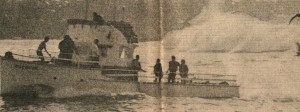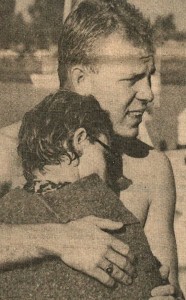THE DUCHESS ADVENTURE ON MISSION BAY
I retired from the navy in 1967 and had not given any thought to what I would do as a civilian. I knew I would miss the excitement of the past 24 military years but I lacked any business knowledge that would fit me for a job with a civilian employer. Without getting into the details I decided to try my hand in the SCUBA diving business, This turned out to be another one of those lucky choices that so often directs our lives. Needless to say after personally certifying over 1000 students in basic and sometimes advanced SCUBA skills, and supervising and assisting my employees to certify another 4000, there were thrills aplenty for all of us. This is the interesting story of one unbelievable day on the diving boat Duchess that I chartered from time to time to give my students an enjoyable and educational offshore experience.
The Duchess adventure was another of those significant events of my SCUBA years. I was running a diving club for all my past students and their friends, and thought up the idea of having a whale dive for advanced students somewhere off San Diego’s Mission Bay. It was scheduled for mid-January because the whales were usually abundant during this time which led me to believe that we wouldn’t have to go out for very long or very far to find the quarry. The idea was to spot a whale or whales moving southward along the coast, and then deploy a line of divers across and perpendicular to their path.
I chartered the 42 foot Duchess, a fishing boat that was sometimes used as a small diving boat and listed the trip in our monthly diving newsletter. Our newsletter editor, Jim Stevenson, was also running our other PR activities and suggested that we try to get Dr. Ray Gilmore, the head mammal curator at the Museum of Natural History, and a grey whale expert, to go along as an observer. Jim was enthusiastically received at the museum and Dr. Gilmore signed on. Cheryl Black, one of our young, but very proficient lady divers, also asked if her dad could come along. He had just suffered a heart attack and she thought it would be nice relaxing interlude for him. I again agreed. This was also the case with the pregnant wife of one of our members, Larry Hecht. She was also welcomed aboard. Altogether we had something like 25 people aboard which included the skipper, Phillip Di Bartola, and one crewman.
It was an overcast day when we arrived, but there was no other indication that the trip would be anything but routine. We clambered aboard with all of our Scuba gear, including tanks, weight and gear bags full of ancillary equipment. The fully pressurized tanks were stowed in racks along the sides with each diver’s weight belt and equipment bag alongside. In the center of the aft deck Di Bartola had anchored a commercial air compressor with sufficient filling capacity to re-pressurize a tank in about five minutes, so it was quite large and very heavy. Once loaded, we cast off the dock lines and headed out the channel to the diving area.
Nothing seemed unusual to me although there were some pretty sizable swells coming down the channel and the boat was alternately climbing over them and running down the backsides. I was a bit concerned about seasickness in some of the passengers but knew that the seas would simmer down once out of the channel. I also knew that the few who were prone to seasickness had been given doses of Bonine, a pill which worked were many others did not. No one got sick. However this is where the story gets complicated. As you leave the bay and enter the channel, heading out, there is a loudspeaker which is used by the area lifeguards and harbor police to issue instruction to boaters who must be cautioned about hazards or who were breaking rules. It was later claimed that this speaker was used that day to warn the Duchess not to leave the harbor because of high seas. I did not hear the warning and Di Bartola claimed that he did not either. I
genuinely believe him.
Once clear of the channel it was not long before we spotted our first pod of whales. There were six of them in a rather tightly clustered school, and they were heading our way. We were about a mile out and the water was not terribly deep. Underwater visibility was perhaps twenty to thirty feet. There was some surge, but this was of no consequence since we wouldn’t be operating on the bottom.
Altogether the situation was almost exactly v/hat I wanted. How could we miss six whales with such perfect conditions? We deployed the divers and waited, and waited and waited. We had not counted on the whales exacting sensors: They had apparently used their sonar capabilities to ping on our metal tanks and quickly altered course to avoid our observation line. Dr. Gilroy noted this as well and confirmed my belief. He mentioned that Captain Cousteau’s men always dived on whales without using SCUBA tanks for the same reason.
Since this had not been planned as a recreational dive, but one to find whales. And since we had found whales and been unsuccessful we decided to terminate the day’s diving and return to the dock. DiBartola swung the ship around and headed back to the Mission Bay Channel. Here is where the problems began.
Waves travel great distances without a very perceptible change, but once they get close enough to the shore they begin to interact with the bottom. The term is, “touch bottom”. Touching bottom slows down the underside of the wave. The upper half is not so affected, and continues at its original velocity. The effect is that the wave builds and steepens. This is easy to see if you watch waves from the beach. Watching beach waves from the shore you can see them steepen as they get closer and eventually become unstable and break. And so it appeared to be happening as we now approached the channel entrance. The waves were indeed steepening and I began to have misgivings. As the leader of this group I went to the bridge and pointed out the situation to Di Bartola. He had noticed it too, but after a short discussion he told me that he had navigated the channel before in similar conditions and that he didn’t anticipate any problems.
I climbed back down to the after deck but I was still worried. Lacking any other options I called out all the divers and guests who had gathered in the lower cabin and had them come out and join me back aft on the outside. By good fortune they all began gathering together on the port side where I was standing with my wife
The Duchess was now two or three hundred yards down into the channel and it became obvious that things were not going well. The waves were causing the bow to yaw erratically, and as each wave went by Di Bartola was spinning the wheel back and forth to compensate and return to his original heading as they passed. Suddenly, and almost without warning, the vessel plunged downward, swung sharply to port and broached steeply, throwing the ship on her beam ends. The wave had become so precipitous that the water forming it had run forward under the ship leaving the boat’s propeller and rudder hanging in mid-air out of the water. The vessel was out of control! From our view it seemed certain that she was going to roll completely over. I grabbed my wife and we were thrown into and then under the water. When we surfaced we were on the seaward side of the boat. We had gone completely under the hull. So had all the other 19 after-deck passengers. Debris was floating everywhere, the pregnant lady was screaming for help and clinging to her husband, others were swimming to join friends and the Duchess, which by some miracle, had not rolled over completely was further down the channel. She was broadside to the waves, and at that point, inoperable.

Now the rescue! The lifeguards who had been watching the approaching vessel had anticipated trouble. They had had the foresight to man three or four of their small “rescue” boats and were now racing out the channel into the enormous waves to rescue the swimmers and to assist in any way they could. I immediately pointed to the pregnant lady when they arrived and she was quickly pulled out of the water. The rest of us climbed or were pulled aboard as soon as the lifeguards could get to us. This was not easy with the cresting seas, but all were finally rescued and taken ashore at the life-guard station.
Somehow Di Bartola got the Duchess going again and limped back to his berth in the Dana Landing marina.
Altogether it was a miracle. No one was hurt. If we had all been on the starboard side when she broached, the falling tanks, weight belts and the compressor, would have probably killed some of us and badly maimed others. The Duchess was a mess but still afloat, and the expensive compressor, which broke loose from its mounts and crashed into the starboard rail, nevertheless stayed aboard, Dr. Gilmore lost has $2,300 Bolex motion picture camera and Cheryl’s dad was shaken but survived without any ill-effects. All our diving gear – tanks, weight belts and equipment, was lost.
As luck would have some newspaper-person was on hand and managed to get the photos shown on this page. That person also conducted some interviews and write up the story for the Union-Tribune paper. A Coast Guard Court of Inquiry found Di Bartola not guilty of negligence and allowed him to keep his small-craft commercial license.
Subsequently I found out that a similar incident had happened in the Channel to a returning fishing boat sometime in the mid-fifties, and I think there were three of four fatalities.
Thank you God!!!!! Don

